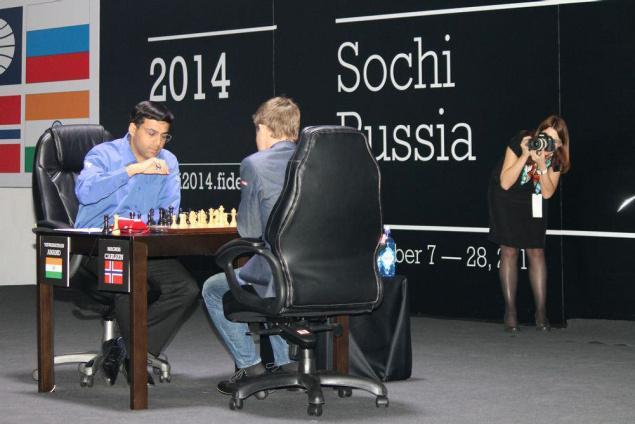
Each time Viswanathan Anand comes out unscathed in a battle against Magnus Carlsen, he regains some ground he conceded in the lost war last November.
A day after hitting back with an authoritative triumph to make the World chess title-match all square, Anand withstood everything that Carlsen hurled at him and eventually made the Norwegian force a draw by perpetual checks in 47 moves in Game 4 of the 12-game match in Sochi, Russia.
As the psychological warfare continued with the score tied at 2-2 — like it was in Chennai last year — Carlsen said on Wednesday, “the score is equal… so far, everything is equal.”
Not quite. In Carlsen’s admission, he played the last two games “pretty bad.” In fact, he said, “I played terribly (in Game 4). I missed several things. Not a very high quality game on my part. No blunders, but, in general, not good enough.”
On the other hand, Anand was exuding confidence. “It was a very complex position. I was not very concerned at any point except when I had to find Qd2 (on move 44). Then I knew, I was saving the game.”
For just under three hours, Anand played with black pieces like he seldom has against Carlsen in their World championship games.
Like in three previous games, a new opening was on view when Anand opted for the classical line of Sicilian Defence. Anand’s decision was clearly to lead Carlsen to a different territory other than Ruy Lopez Berlin that gave the Norwegian Game 2 on a platter on Sunday.
Again, for the fourth time in succession, Anand looked in control of the opening phase. He dared to have an isolated Queen-pawn, also known as ‘isolani’ that could have come become Carlsen’s target if not protected timely and adequately.
The position looked equal and balanced until the 22nd move when the game entered the fourth hour. The character of the position was such that if the players made the critical moves, based on their deep, home preparation, the game would have seen mutual elimination of forces, resulting in a draw.
But suddenly, Anand chose to be defensive. Particularly after the manner Anand emerged from the opening, his decision was hard to understand.
In an equal position, he started defending with his knight getting closer to the castled king, without any apparent threat from Carlsen.
It is well known that Carlsen loves such positions. With no threat of losing, he is capable of “playing forever”, as Russian Grandmaster Peter Svidler pointed out. Anand’s passive approach, aimed at earning a draw and not a win, made Carlsen feel better.
Indeed, one couldn’t ignore Carlsen’s success-rate in such listless positions. Anand was required to play accurately to deny Carlsen any hope of improving his chances.
A draw could happen only after Carlsen had exhausted all his options. After further simplification, that left the players with a queen, a knight and five pawns each, Anand seemed to have a more definite plan to draw.
In fact, one of Anand’s pawns was in the central file, with its adjacent files devoid of Carlsen’s pawns. This held some hope for Anand in case he managed a timely exchange of queens.
After 32 moves, the players had 14 minutes each to make eight moves to avoid losing on time. On the 34th move, Carlsen offered the exchange of queens that Anand declined and chose to consolidate his defence. Two moves later, the exchange of knights brightened prospects of a draw, leaving the queens to battle for superiority.
Once the players completed 40 moves and became eligible for another hour each for the next 20 moves, Carlsen chose to keep Anand longer on the board. But once Anand found the right defensive plan, Carlsen took a draw by perpetual checks.
